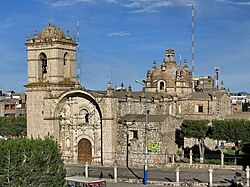Juliaca is a city of 276,000 people (2017) in the Peruvian Altiplano. Juliaca is a large trade center for goods and services, and is considered the financial capital of the Puno region.
Understand
[edit]Juliaca is 3,825 metres (12,549 ft) above sea level, is located on the Collao Plateau and is northwest of Lake Titicaca (45 km). It is the largest trade center in the Puno region.
It is nicknamed "The Windy City", in its case, because of the city's location on the windy Collao Plateau. It is also called the "Sock City" or "Knitting City" because Juliaca was a major center of sock, sweater, and handicraft production. Now the production of clothes, wool and fabrics are industrial processes.
Get in
[edit]By plane
[edit]- 1 Inca Manco Cápac International Airport (JUL IATA) (NW part of town, 5 km northwest from the Plaza de Armas in the city along Av Ferrocarril and Av Aviancion). is the nearest airport to the western shores of Lago Titicaca at Capachica (40 km east) and Puno (42 km south) with the following airlines:
By bus
[edit]The 2 Terminal Terrestre is about a 20-minute walk (2 km) (or a much faster taxi ride) east from the Plaza de Armas. Daily buses depart to and from Cusco (6 hr); Arequipa (4 hr); Puno (50 min); Copacabana and Lima (18 hr 12 min via Arequipa) with some of the following:
By car
[edit]Get around
[edit]See
[edit]
- Mother Church of Santa Catalina (Iglesia Sta Catalina), Plaza de Armas. It presents an indigenous baroque architectural style. The Jesuits began its construction in 1649, but it was not completed until 125 years later. Its bell tower was built entirely with ashlar brought from the quarries of Arequipa. It is under the command of the Franciscan congregation. In its structure, carved ashlar predominates. Its dome, its doorway and bell tower stand out. Works of art, such as canvases, are preserved inside.

- Church of La Merced (Iglesia de la Merced) (in the west wing of Plaza Bolognesi in the city center). This church is a beautiful work of architecture from the time of the republic. Carved in red limestone and with a structure typical of the modern era (iron frame). Like the main Church of Santa Catalina, it only has a symmetrically arranged bell tower unlike the previous one, and it also features a clock with four circular faces. It was inaugurated in 1959 and renovated in 1995, where indigenous elements were included.
- Franciscan Convent (Convent of Santa Bárbara) (on the Hatun Rumi or Santa Bárbara hill (Spanish name), 40 m from the Plaza de Armas of Juliaca). It is a four-level building built, it has an essentially Romanesque style. It is built from rocks, bricks, iron and cement; roofed with stainless steel sheets. It has four levels and impressive arched windows, totaling more than a hundred finely finished and clear Greco-Roman style. It also highlights a watchtower and a flanking tower, which suggest the idea of being a medieval castle.
- Cristo Blanco del Mirador Huaynarroque (southeast of the Plaza de Armas, on the summit of the Huaynarroque hill). Colossal work embodied in reinforced concrete and fiberglass, which represents the image of the vigorous redeemer, with outstretched arms. It has good night lighting, which highlights a sacred purple and radiant heart. At the foot of the monument there is a viewpoint, from which you can contemplate the urban and non-urban area that includes the city of Juliaca. The complex was built in just two and a half weeks, and was inaugurated in 1987.
- Las Calceteras Gallery (in the north wing of Plaza Bolognesi). It is a three-story crafts shopping center, which sells all types of garments (socks, chullos, booties, shawls, sweaters, rugs, gloves, etc.) woven or made with native materials (llama, alpaca, vicuña). You can also see the handwork done by the artisan women with their typical clothing (called the hosiery), in different types of wool and fibers.
- Chacas Lagoon (10 km northwest of Juliaca in the area of the towns of Kokan and Chacas). It is a lagoon surrounded by vast hills, such as Iquinito (which is the highest in the area). Local flora and fauna abound in this lagoon, mainly during the summer (rainy season).
Do
[edit]The city hosts Juliaca's Carnival each year between February and March. During this very popular event participants, dressed in colorful costumes, gather on the streets to dance in the style of the Collao Plateau. Saint Sebastian's feast is celebrated on 20 January of every year.
Buy
[edit]Eat
[edit]- La Fuente de la Salud, Jr. Jorge Chavez N° 215 (around the corner from Hotel Sakura). A very nice vegetarian restaurant. S/6 for a very complete menu. Clean and friendly staff. Definitely worth stopping by if you are in town.
Drink
[edit]Sleep
[edit]Travel to Puno for lodging.
- Hotel Sakura (San Roman 133). Check-out: 13:00. Clean hotel, cable TV, wireless internet. Pretty decent accommodation. S/70 for a double.
Connect
[edit]- Lampa, 35 km northwest of Juliaca on Carr Lampa-Juliaca, has an impressive colonial church and catacombs with an exact replica of "La Pieta" of Michelangelo, and South American camelids.
Go next
[edit]
